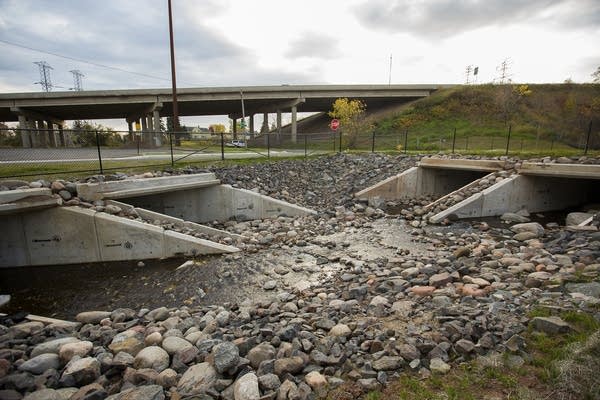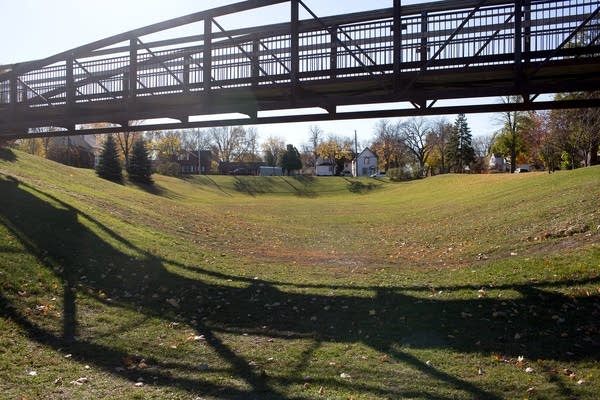As climate changes, cities grapple with big rains

Go Deeper.
Create an account or log in to save stories.
Like this?
Thanks for liking this story! We have added it to a list of your favorite stories.
Climate Change in Minnesota: An MPR News special report
In Duluth, city workers have replaced 8-foot culverts wiped out in a 2012 storm with two sections 10 feet wide, more than doubling their capacity.
In Minnetonka, the city is creating computer models to see where increased rainfall is putting the most pressure on its stormwater system.
Turn Up Your Support
MPR News helps you turn down the noise and build shared understanding. Turn up your support for this public resource and keep trusted journalism accessible to all.
In north Minneapolis, a street has been torn out to make room for huge tanks that can store stormwater and prevent it from overwhelming the city's system that drains into the Mississippi River.
In all three cases, whether officials say it in so many words or not, they are adapting their cities' infrastructure to a changed climate, one that has been dumping more rain and bigger rains on Minnesota.
Warmer temperatures have an impact on infrastructure as well - more freeze-and-thaw cycles mean more potholes, for example. But because roads require relatively constant maintenance, road planners can adapt to a changing climate on the fly.
Not so with storm and wastewater systems, which are built to last as long as a century. That, say urban planners, is where the real challenge lies, and it is where some Minnesota cities have been focusing their efforts to adapt to climate change.

The amount of rain falling in very heavy events has increased 37 percent in the past half century in Minnesota, according to the National Climatic Data Center. Five of Minnesota's largest rainfalls ever recorded have occurred since 2000.
That includes a June 2012 whopper that poured up to 10 inches of rain on Duluth. Flood waters gushed through the city. A creek burst out if its stormwater tunnel and flooded University of Minnesota Duluth senior Nicole Kor's apartment.
"The 100-year storm for the Twin Cities area has gone from about 6 inches of rainfall, to closer than 8 inches of rainfall."
"Water started gushing through my window because the current was up to here," Kor said. "I have never experienced something so terrifying."
The city's mayor, Don Ness, said, "We saw culverts overwhelmed. We saw roadways simply washed away because there was so much water that it overwhelmed our system.
"It was a real eye opener for our community to see that our infrastructure simply wasn't up to the task, given our changing realities."
Duluth relies on a sprawling storm drainage system, a network of pipes, ditches, culverts, catch basins and dozens of natural streams to funnel runoff into Lake Superior.

That system was designed to handle a 100-year storm, defined as the severity of storm that can be expected - statistically - every 100 years at a given location.
But what was once a 100-year storm has been happening more frequently.
The state has spent $450 million to help communities like Duluth rebuild from the five biggest rainstorms this century. The federal government, individuals, and cities and counties have spent hundreds of millions more.
Where it can, Duluth has used the money to install more resilient infrastructure.

"Our design standards are now newer and updated, so we had to upsize them to meet these new design standards, so we couldn't put back what was existing," Chris Kleist, the city's stormwater manager, pointing out the new and larger culverts.
Engineers build infrastructure to be able to handle a certain size rain event. For the past several decades the way they have done that is to consult a National Oceanic and Atmospheric Administration publication known as "Technical Paper 40."
It provides detailed storm expectations for thousands of places around the country, but it was published in 1961.
So Minnesota helped spearhead the creation of a new document, called Atlas 14, that includes much more recent data from a lot more places.
"So, for instance, the 100-year storm for the Twin Cities area has gone from about 6 inches of rainfall, to closer than 8 inches of rainfall, which is a big change," said Randy Neprash, an engineer with the Minnesota Cities Stormwater Coalition.
That's a 32 percent increase. Duluth's 100-year storm increased by 27 percent in the new document.
Leading the charge to adopt the new rules is the Minnesota Department of Transportation, which pushed for the new data and helped rally neighboring states to contribute money.
"To be honest we don't usually refer to climate change. That tends to be a little bit of a hot button word."
The department recently completed a climate change assessment of state highways in northeast and southeast Minnesota, and Philip Schaffner, MNDOT's policy planning director, said he was surprised to learn some fixes seem fairly manageable.
"It doesn't necessarily have to be a big large giant project to adapt our infrastructure," Schaffner said. "In fact our normal improvement program over time might be able to make things dramatically better."
The city of Minnetonka is also using the new precipitation data to find vulnerabilities in its stormwater system.
"To be honest we don't usually refer to climate change," said water resources engineer Liz Stout. "That tends to be a little bit of a hot button word."
Even though the city is indeed adapting to climate change, she said she focuses on the data, the documented increase in extreme rainfalls.
"And as long as the streets can hold the water, you possibly might want to think about a rain day, or a flood day, just like a snow day."
"People are seeing that, people are noticing that," Stout said. "We get calls all the time here at the city of people saying, 'I don't remember having these kinds of rainfalls, I don't remember springs being this wet.'"
The city has hired a consultant to plug the Atlas 14 numbers into a computer model that shows how different sizes of rainfalls would flow through the city's stormwater system, revealing where flooding could occur.

Some have referred to this as "adaptation by stealth," preparing for climate change without really using that language.
Sanitary sewer systems can also be vulnerable to extreme rain when water leaks into pipes or is funneled there through basement sump pumps. Heavy rains in June 2014 caused sewage overflows at a record 126 treatment plants around the state, some of which closed beaches on Lake Minnetonka.
One city, Adams in southern Minnesota, had to release untreated sewage 11 times during heavy storms between 2011 and 2013 to avoid sewer backups into homes. To fix the problem, the town disconnected more than 100 sump pumps from the sanitary sewer system, and a nine-inch storm in June 2014 generated no emergency sewage releases.
It's one thing to adapt to change Minnesotans have already seen. It's another to build for expected continued change.

A recent study for the Minnehaha Creek watershed district found that about 40 percent of the existing stormwater pipes in a part of southwest Minneapolis would be too small to convey runoff from a 10-year storm under the most pessimistic climate change scenario.
Researchers led by Michael Simpson, director of Antioch University's Center for Climate Preparedness and Community Resilience, found that farther west in Victoria, policies to protect wetlands and to cluster new development had created a system more resilient to climate change.
Simpson recommended a host of flood control features, most of which Minneapolis has been building for several decades. Those include big storage ponds and dry basins -- huge grassy bowls that fill up with rainwater during big storms. But Minneapolis stormwater director Lois Eberhart says to build those, the city had to take out dozens of homes.
"There was concern of breaking up neighborhoods, taking some affordable homes that were in good condition," Eberhart said.

So, the city is starting to look underground.
One example is the north Minneapolis pilot project where stormwater tanks were installed beneath what once was a street 5½ blocks long but now is a pedestrian and bicycle path.
"They are huge," she said of the tanks. "Some of them are up to 18 feet wide by about 10 feet tall, one after the other after the other."
So far, the system has worked, Eberhart said, but it cost $6 million. To build more would be expensive, an estimated $40 million to $70 million just in the 1,000 acres that drain into Lake Hiawatha.

Minneapolis and other cities are installing what is known as "green infrastructure." Rain gardens and permeable pavement allow more rain to soak into the ground rather than run into stormwater pipes. St. Paul and the Metropolitan Council built the largest "tree trench" in the country along the Green Line light rail corridor, using storm water to irrigate 1,000 trees.
But those projects are designed to deal with the first inch of rain, not the big storms that have hit Minnesota more frequently in recent years.
It's hard to justify spending big money when there is so much uncertainty associated with storms, said Todd Carlson, a stormwater utility coordinator for Duluth.
"To go to council and say we need to do this because we feel that the climate's going to change, we need to be spot on with that," Carlson said. "If we get it and we hit it, we're heroes. If we miss it, then we spent the public's money foolishly."
Engineers say what's important is to make sure the biggest storms don't threaten lives or severe property damage, by providing safe places for the water to flow.
That could mean the public will need to change its expectations, said Antioch University's Michael Simpson.
"And as long as the streets can hold the water, you possibly might want to think about a rain day, or a flood day, just like a snow day."
Dear reader,
Political debates with family or friends can get heated. But what if there was a way to handle them better?
You can learn how to have civil political conversations with our new e-book!
Download our free e-book, Talking Sense: Have Hard Political Conversations, Better, and learn how to talk without the tension.




